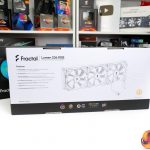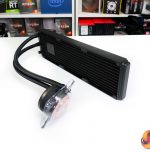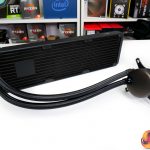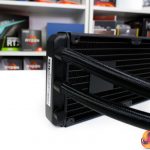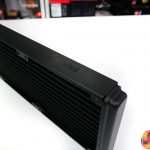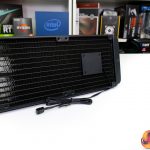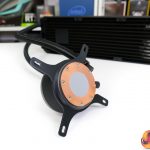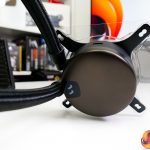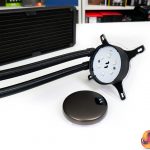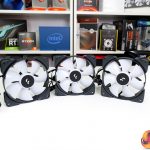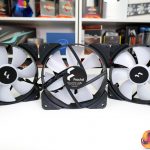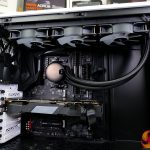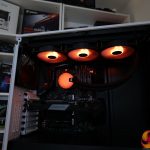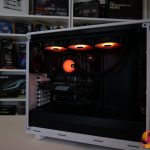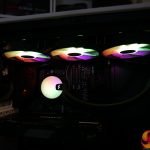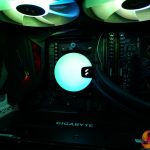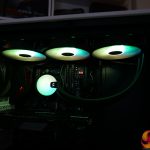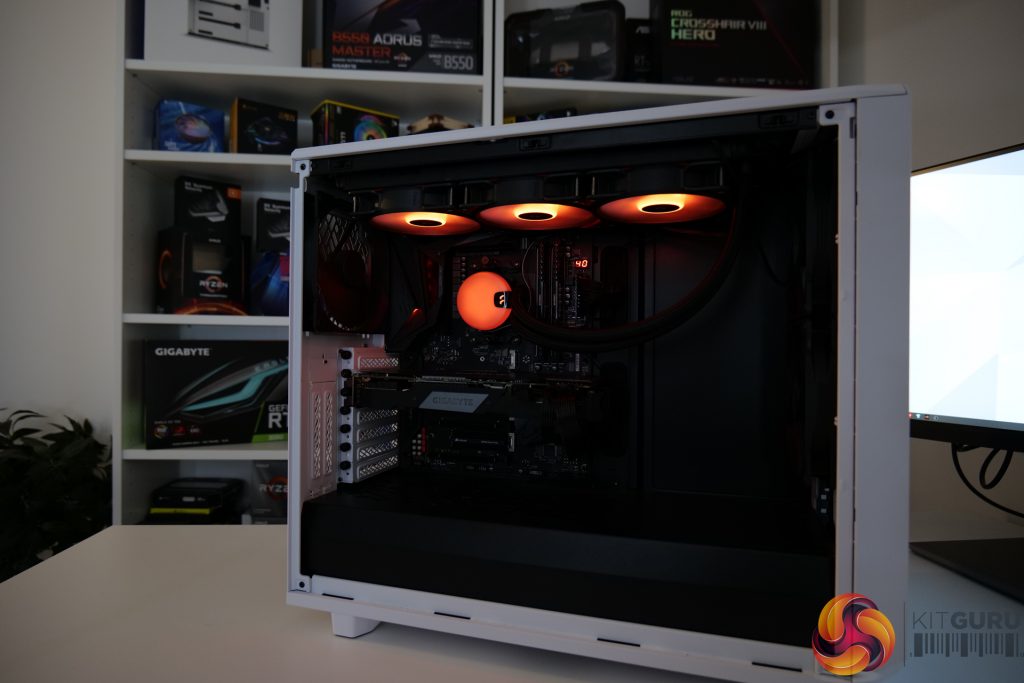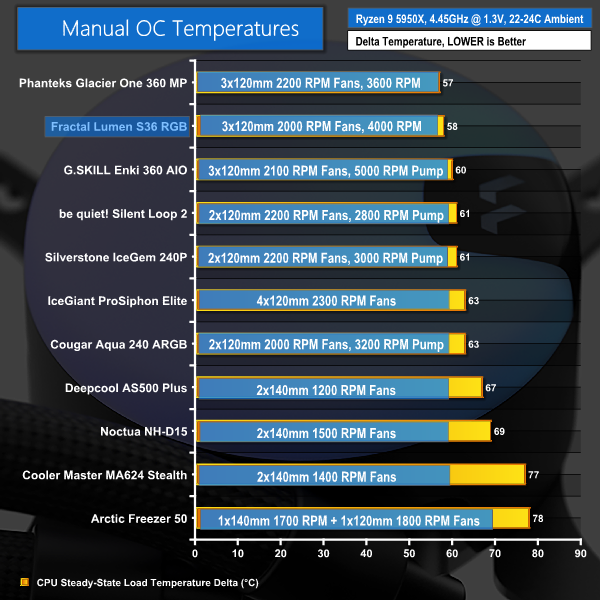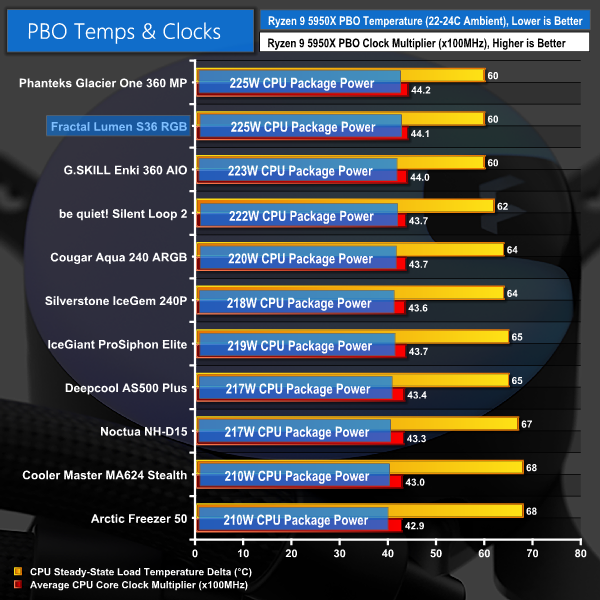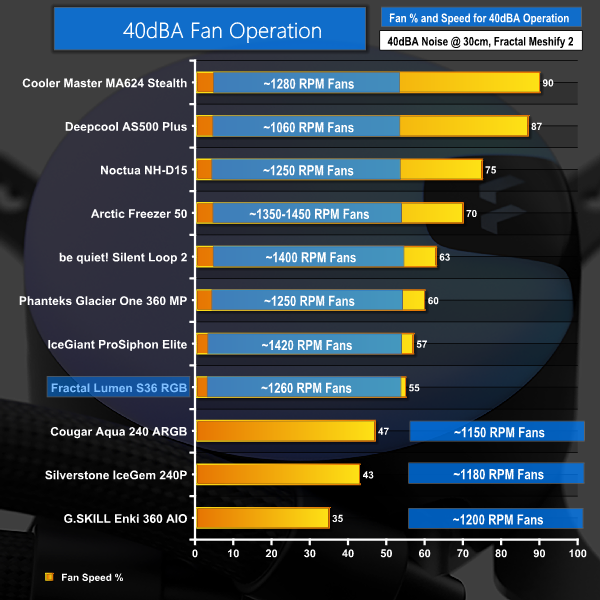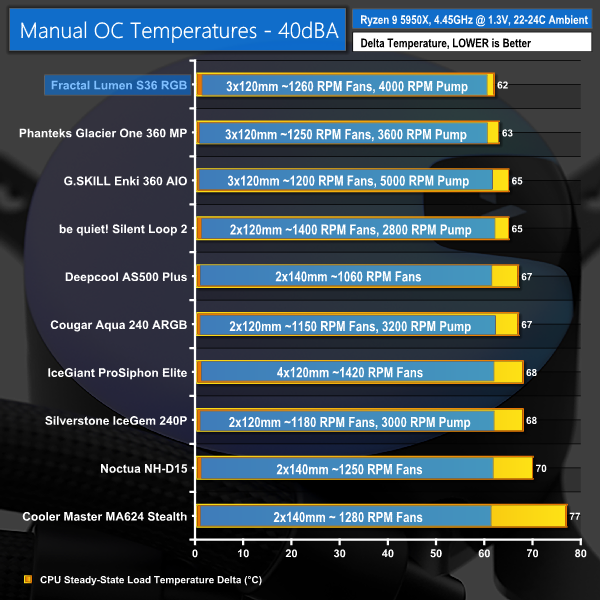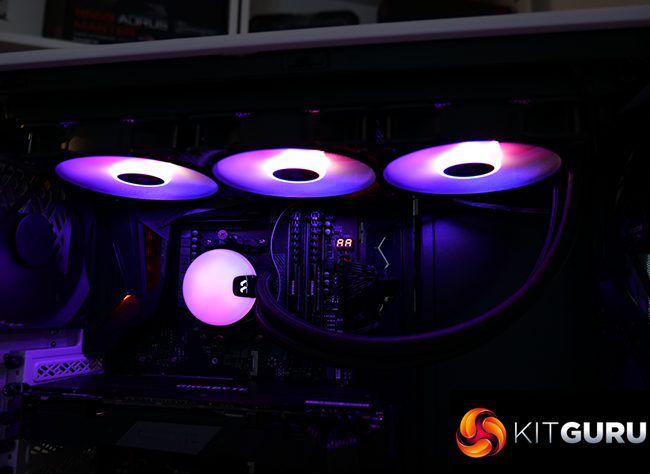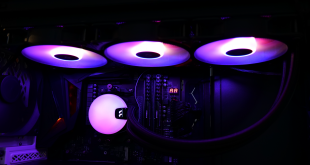
Fractal’s new Lumen All-In-One (AIO) liquid coolers are aiming to offer high-end cooling performance and premium ARGB lighting at an attractive price point. Available in 240, 280, and 360mm versions, we are focusing specifically on the flagship 360mm Lumen S36 RGB priced at £112.99 in the UK.
The key feature of Fractal’s new Lumen RGB series of coolers is clearly the lighting design. Brand new Aspect fans emit an RGB colour spectrum glow, while the water block cover plate is in essence a full-sized lighting board; LEDs located beneath the plastic cover provide significant levels of RGB light.
One interesting aesthetic feature is the ability for the water block cover plate to be repositioned at 90-degree intervals. This ensures that the Fractal logo is displayed upright, no matter your AIO cooler block mounting orientation. While a good idea in practise, the ARGB lighting cable can only be installed on one side, so the benefits of rotating the RGB cover are somewhat offset by limited cable management abilities.
Looking at the radiator, it is a conventional 27mm thick aluminium design. This comes as little surprise as it is basically the go-to option for off-the-shelf AIO liquid coolers from the major OEMs. Fin density is what I would describe as standard and the colour is obviously a deep, consistent black.
Emerging from the radiator are the cooler’s pair of 400mm-long liquid tubes. Low-permeability rubber with a braided nylon sleeve are used to provide function and form.
One interesting design feature is the positioning of the powered pump within the radiator fin array. This is likely a design decision intended as to not infringe upon the Asetek patents. Fractal makes reasonable effort to allow a user to hide the 4-pin power cable with routing slots on both radiator side walls.
The pump is rated at 4000 RPM and uses a ceramic bearing type, but it lacks PWM speed control which is a major downside versus (more expensive) Asetek competitors. MTTF is rated at 50,000 hours, which is decent enough when coupled with the reasonable 5-year warranty.
At 43mm block height and 67mm diameter, the compact unit should fit well inside confined motherboard areas. A copper coldplate is used for CPU contact and this comes with pre-applied thermal paste. Intel and AMD mainstream platforms are supported, but there is nothing for Threadripper.
The tubes that enter the compact block unit are able to rotate by 90 degrees, thus allowing more flexibility with the install.
Fractal equips the Lumen S36 RGB with three of the company’s new Aspect 12 RGB PWM fans in 120mm form.
These seven-blade, rifle bearing blowers utilise a semi-opaque white colouring alongside six hub-mounted RGB LEDs to create their ARGB lighting appearance. Their rated MTTF is 90,000 hours.
The 4-pin PWM cable allows for a speed control range of 500-2000 RPM, which is strong on the low-speed side of things. And Fractal smartly includes a daisy-chain approach for connecting the 3-pin ARGB and 4-pin PWM cable of each fan. While smart in practise, the cable lengths are needlessly long given that each fan will be sat directly next to another, and this adds some cable management burden.
Fractal’s OEM for the liquid cooling hardware is Apaltek, and we got it confirmed that this is their 3rd generation design.
Installation is as straightforward as we would expect for a quality AIO cooler, especially as the default AMD backplate and retention brackets are used.
Once you switch out the default Intel block bracket to the included AM4 option, it is simply a case of tightening the block in place and then fitting the radiator and fans to the chassis.
Once the cooler is installed, the visual appearance is very good. That is the case thanks to minimal cabling being required from the motherboard, thanks to the daisy-chain design.
RGB lighting control is handled by all of the main motherboard vendors’ go-to programs, in addition to Razer’s RGB solution. I personally prefer this approach – as opposed to using a cooling vendor’s dedicated software. It’s more seamless and enables better sync. However, some users with poorer motherboard control abilities may miss a dedicated RGB tool from Fractal.
There are several perfectly valid ways to test CPU coolers. We are primarily focussing on the performance of each cooler at 100% fan speed and also when locked to 40dBA noise output. We will focus on cooling performance using a manual overclock and Precision Boost Overdrive, as well as some reference to stock numbers. We will also highlight VRM temperatures.
We decided to test using a chassis as we feel that this is most representative of real-world use cases. It does have some unwanted influences on the test data, as does open-air test bench testing. But we feel that this is a worthwhile trade-off for real-world chassis performance of the coolers.
Our chassis of choice is the Fractal Design Meshify 2 case that Leo reviewed and scored very highly. We like this chassis thanks to its high airflow optimisation and well-vented front and top panels.
The fan configuration is the three included Fractal Dynamic X2 GP-14 fans spinning at full 1000 RPM speed. In addition to the two 140mm front-mounted fans, and single 140mm rear exhaust, we added a be quiet! Pure Wings 2 1000 RPM 140mm fan as roof exhaust for air cooler testing. The aim here was to keep consistency with the airflow path of the liquid coolers which are always roof mounted.
CPU Cooling Test System:
- Processor: AMD Ryzen 9 5950X
- Overclocked Settings: 4.45GHz all-core @ 1.312V (UEFI), Medium LLC – around 1.3V delivered
- Motherboard: Gigabyte B550 Aorus Master
- Memory: 32GB (2x16GB) Corsair Vengeance LPX 3600MHz 16-18-18-36 DDR4 @ 1.35V
- Graphics Card: Gigabyte RTX 2060 Super 0dB Mode
- Chassis: Fractal Design Meshify 2
- Chassis Fans: 2x140mm 1000 RPM Fractal Front Intake, 1x140mm 1000 RPM Fractal Rear Exhaust, 1x140mm 1000 RPM be quiet! Pure Wings 2 Roof Exhaust (for air cooler testing)
- Power Supply: Seasonic Prime TX-1000
- OS SSD: Corsair MP600 NVMe M.2 SSD
- Operating System: Windows 10 Pro 64-bit
Comparison Coolers:
- Fractal Lumen S36 RGB – £112.99, 3x120mm 2000 RPM Fans, 4000 RPM Pump
- be quiet! Silent Loop 2 – £119.99, 2x120mm 2200 RPM Fans, 2800 RPM Pump
- Deepcool AS500 Plus – £64.99, 2x140mm 1200 RPM Fans
- Noctua NH-D15 – £80, 2x140mm 1500 RPM Fans
- Cooler Master MA624 Stealth – £99.99 MSRP, 2x140mm 1400 RPM Fans
- Arctic Freezer 50 – £59.99, 1x140mm 1700 RPM + 1x120mm 1800 RPM Fans
- Cougar Aqua 240 ARGB – £89.99-£99.99 MSRP, 2x120mm 2000 RPM Fans, 3200 RPM Pump
- Silverstone IceGem 240P – £119.99, 2x120mm 2200 RPM Fans, 3000 RPM Pump
- Phanteks Glacier One 360 MP – £154.99, 3x120mm 2200 RPM Fans, 3600 RPM Pump
- G.SKILL Enki 360 AIO – $179.99 MSRP, 3x120mm 2100 RPM Fans, 5000 RPM Pump
- IceGiant ProSiphon Elite – £169.99, 4x120mm 2300 RPM Fans
Testing Methodology:
- For testing, we use a 30-minute looped run of Cinebench R23 and record the steady-state CPU temperature at the end of the test. This ensures that the CPU has had ample time to warm up and reach steady state under all of the coolers.
- Ambient is maintained around 22-24 degrees Celsius. Where there is variation beyond this temperature range, we add in extra repeated tests to ensure consistency.
- We also test each cooler with at least two fresh installs (typically three) to mitigate the likelihood of a dodgy mount spoiling results.
Let’s start off with noise performance from each cooler at 100% fan speed.
This is important as it sets the precedence for which coolers we expect to deliver the higher levels of performance based on the faster and louder fans. Assuming that their performance is efficient in comparison to their noise output levels, that is.
The chassis fans are disabled, all case panels are on, and the sound meter is placed 12 inches from the side of the Fractal chassis’ glass side panel – roughly where a desk user will be sat.
Fractal's Lumen S36 RGB makes a promising start in the noise output test by managing to match the levels shown by be quiet!'s impressive Silent Loop 2. This is a particularly good result for Fractal, as the be quiet! cooler has one less fan and uses the superb Silent Wing 3 PWM models.
Fractal looks to have done a good job with the new Aspect 12 RGB PWM fans, based on this initial noise test. This is the quietest 360mm AIO cooler that we have tested to date, and that is by quite a margin.
It will be imperative to see if the Lumen S36 RGB is able to keep pace with the other AIO coolers and their typically higher speed fans.
Our overclocked test is the main stress test and represents a very tough challenge for these CPU coolers. As we are locking the voltage and clock speed, the temperature figures are directly comparable between competing coolers.
We see package powers in the order of 220W for the CPU and wall power levels that exceed 300W for the system. There is a caveat whereby lesser performing coolers force the CPU to run at higher temperature levels. This, in turn, reduces the operating efficiency and dictates that the CPU draws more power. This increased power draw results in higher operating temperatures, thus further negatively affecting the thermal performance.
This small degree of thermal runaway – albeit very limited in system divergence terms – is important with our manually overclocked 5950X CPU. It perhaps seems unfairly weighted against the lesser performing CPU coolers. But it is the reality of real-world operation whereby higher performing CPU coolers can sometimes show disproportionately better temperature performance at the higher thermal load levels.
Note the use of delta temperature data in our charts and factor in your own ambient conditions for reference.
Based on full fan and pump speed performance, the Fractal Lumen S36 RGB is an excellent choice for our heavily overclocked Ryzen 9 5950X test processor.
Fractal's new 360mm RGB model is able to outperform all other comparison products in our chart, except for the high-end (and expensive) Asetek-based Phanteks 360mm AIO. And the margin of difference there is very small.
Factoring in price and noise output at this early stage, the Fractal cooler looks incredibly promising.
We won’t put too much emphasis on PBO results, but we will spend some time to quickly analyse them using our full fan speed data.
With 90C the maximum target temperature for PBO, we are looking for the cooler that achieves the balance between lower temperature operation and higher PBO clock speeds. Higher clocks with lower temperatures are better. But one cooler may run at slightly higher temperatures than another, albeit with higher clock speeds, so look out for that.
In essence, this test is showing us how far the coolers can be pushed while keeping a sensible 90C maximum. Or whether there is more room for pushing clocks and power delivery beyond the PBO limits while still sticking to a 90C target.
The same exceptional cooling performance continues with our PBO test. This time, the Fractal cooler manages the same power cooled as the Asetek Phanteks competitor, but it is behind on the CPU clock measure by a very slim margin.
G.SKILL's ENKI 360 AIO – the other 360mm comparison cooler – is beaten by Fractal's Lumen S36 RGB.
Having assessed the coolers at full fan speed, we see clear separation between the AIO cooler performance with their high-speed, loud fans and the competing lower-speed fan air coolers. As such, we have a look at some test results with the noise levels locked to 40dBA on each CPU cooler.
This noise-normalised test is perhaps a little unfair towards AIO liquid coolers and air CPU coolers with dense fin arrays. Those designs need high pressure fans to penetrate the dense arrays and this usually comes in the form of high-speed and loud fans.
With that said, noise is noise when it comes to user tolerance, so the way in which a cooler is designed and optimised is not necessarily a concern to a user simply wanting low-noise, 40dBA-type operation.
Cranking the fans down to 40dBA required a speed percentage of 55%, which registered as around 1260 RPM according to our motherboard header reading.
This is quite a significant loss in speed percentage compared to some of the other AIOs, including those that were louder at full fan speed.
It looks like the 4000 RPM, non-PWM pump unit in Fractal's AIO is having slightly more influence on the cooler's noise output as fan speeds are reduced.
Let’s see how the demanding OC stress test thermal performance hierarchy changes with a 40dBA lock on the noise output.
Despite losing slightly more of its fan speed percentage versus the other AIOs, Fractal's Lumen S36 RGB locked at 40dBA noise output delivers excellent cooling performance.
This time, we see the Apaltek 3rd Gen-based Fractal cooler taking its first victory versus the Asetek Phanteks 360mm AIO. The margin is, once again, very tight. But Fractal's Lumen S36 RGB is continuing to show impressive cooling capabilities even at a more refined and tolerable noise level.
This is particularly promising when accounting for the wide speed range control of the PWM fans at 500-2000 RPM.
We highlight VRM temperatures when using each cooler on our Gigabyte B550 Aorus Master motherboard with the overclocked Ryzen 9 5950X. Do note that the results are heavily influenced by the specific layout of the Gigabyte B550 Aorus Master test motherboard with respect to top-side or rear IO-side VRM components. So your findings may vary if you have a different motherboard VRM layout and heatsink design.
VRM cooling is simply mediocre and is nothing to be particularly impressed by. With a test system similar to ours, the Fractal AIO should provide enough incidental airflow to keep the VRM sufficiently cooled.
But if you have a motherboard with lesser performing VRM heatsinks, don't expect the Lumen S36 RGB to compensate in terms of VRM cooling.
With the Lumen RGB series of AIO coolers, Fractal has aimed to offer high-end cooling and complementary ARGB lighting alongside an attractive price point. That is exactly what the Fractal Lumen S36 RGB achieves!
Shipping in 360mm format and based around the Apaltek 3rd Gen liquid cooling design, we were hoping for solid performance from the offset and that is just what we got.
Fractal's AIO with 3x120mm 2000 RPM fans was just a smidgen behind the more expensive Asetek 3x120mm 2200 RPM Phanteks cooler. And with the noise locked at 40dBA, the Aspect 12 RGB PWM fans proved their worth by projecting the Lumen S36 RGB to a minor victory over the Phanteks Asetek-built unit.
There are just a few minor downsides though. The daisy-chain approach for cable connections is superb, but the cables are rather long and make management less pleasant. That pump cable in the middle of the radiator can be a bit awkward. And the one-sided RGB header on the block does not match the convenience of the 90-degree rotatable plastic cover. A 5-year warranty is absolutely fine.
Those are pretty inconsequential criticisms considering the cooling performance is strong, the noise performance is reasonable, and the cooler's RGB lighting quality is excellent. Add in the £112.99 price which is particularly attractive for a 360mm AIO with this level of RGB lighting, and I am happy to give the Fractal Lumen S36 RGB cooler a strong recommendation based on our test results.

You can purchase the Fractal Lumen S36 RGB 360mm for £112.99 MSRP with availability soon at e-tailers such as Overclockers UK.
Discuss on our Facebook page, over HERE.
Pros:
- Strong thermal cooling performance.
- Tolerable full-speed noise levels.
- Aspect 12 RGB PWM fans do a good job.
- 5-year warranty is fine.
- Very competitive price point, especially versus Asetek OEM competitors.
- Very simple AMD installation.
- Eye-catching RGB setup.
Cons:
- Daisy-chained cables are excessively long and messy – plus, braided would have been preferable.
- The rotatable block cover is good, but the one-sided connection cable dampens the experience.
KitGuru says: Offering strong cooling performance, reasonable noise levels, and an attractive RGB lighting system for £112.99, the 360mm Fractal Lumen S36 RGB feels like a very good buy.
Be sure to check out our sponsors store EKWB here
 KitGuru KitGuru.net – Tech News | Hardware News | Hardware Reviews | IOS | Mobile | Gaming | Graphics Cards
KitGuru KitGuru.net – Tech News | Hardware News | Hardware Reviews | IOS | Mobile | Gaming | Graphics Cards



